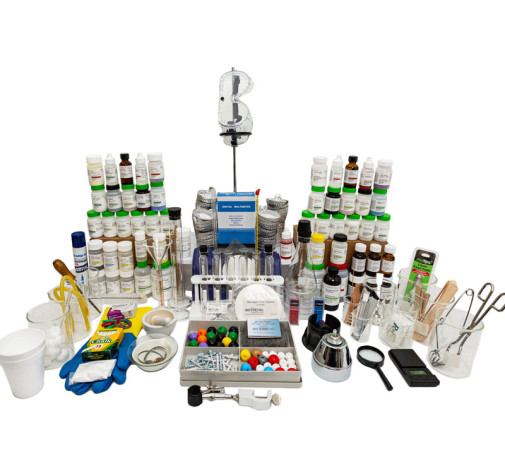We use cookies to make your experience better. To comply with the new e-Privacy directive, we need to ask for your consent to set the cookies. Learn more.
Lab Kit for use with Abeka Science Grade 11
Get everything that you need to complete the labs in Abeka Chemistry: Precision and Design for grade 11, 3rd edition in one simple kit. This kit contains 95 components that make it easy to teach your homeschooler or a small group of students about the world of Chemistry. A balance is also recommended for completing some of the activities.
Contents List: Chemical Splash Safety Goggles, Adult;Lab Apron; Pipets; Safety Gloves, size 8 - 8.5 Medium;Extra Large Test Tubes, 20 x 150 mm; Test Tube Brush;Test Tube Rack; 250 mL Glass Beakers; 400 mL Glass Beakers; Portable Micro Lab Burner; Butane Gas Fuel; Test Tube Clamp; File; Wire Gauze w/ ceramic center; Glass Tube, 5 mm, 12"" long; Rubber Stopper, # 6.5, 1-hole;Superior Balance Digital Pocket Scale, 600 g capacity, 0.1 g precision; 100mL Glass Graduated Cylinder; Stainless Steel Spatula; Glass Stirring Rod; Glass Funnel; Support Stand and Ring Support; Weighing Boats, aluminum, 57 mm, 100 pack;Filter Paper, 11 cm, 10 pack; Watch Glass; 10 mL Glass Graduated Cylinder; Rubber Stopper, #2, solid; 50 mL Glass Beaker; Evaporating Dish; Crucible & Beaker Tongs; Steel Wool; Mortar and Pestle; Copper Wire, 6"; Thermometer;Capillary Tubes, 10 pack; Red Litmus Paper, 100 strips;Blue Litmus Paper, 100 strips; Styrofoam Cups; Wooden Splints, 20 pack; Molecular Model Set; 250mL Glass Erlenmeyer Flask; Rubber Tubing, 4.8 mm, 2' long; Plastic shoe box and cover; Magnifying Glass; Rubber Stopper, #6.5, 2-hole; Economy Laser Pointer; 25 mL Glass Graduated Cylinder; 50 ml Burette; Burette Clamp; pH Papers; Nail assortment; Cotton Balls; Digital Multimeter; Alligator Clip Leads, 2 pack; Brass Brads; Tongue Depressors, 10 pack;Petri Dishes; Chemicals Included: Glycerin, 30 ml, Copper II Sulfate (cupric), 30 g; Sodium Hydroxide, 30 g; Carbon, lumps, 30 g; Pure cane sugar packets; Copper Metal Shot, 60 g; Sulfur, 30 g; Sodium Chloride, 30 g; Chalk (calcium carbonate); Hydrochloric Acid, 12M, 30 ml; Magnesium Ribbon, 60 cm; Zinc, metal electrode, 4"; Calcium Metal, turnings, 10 g; Potassium Iodide, 30 g; Ammonium Hydroxide, 30 ml; Lead Nitrate, 30 g; Sodium Sulfate, 30 g; Copper, metal electrode, 4"; Sodium Bicarbonate, 30g; Silver Nitrate, 2 g; Potassium Chloride, 30 g; Sodium Carbonate, 30 g; Calcium Chloride, 30 g; Zinc Powder, 15 g; Acetone, 30 ml; Potassium Chromate, 30 g; Sulfuric Acid, 18M, 15 ml; Baking soda, 50 g; Acetic Acid Solution 1 M, 100 mL; Barium Hydroxide, 10 g; Magnesium Sulfate, 100 g; Barium Chloride, 15 g; Ammonium Chloride, 30 g; Fertilizer Soluble, 30 g; Strontium Chloride, 10 g; Lithium Chloride, 30 g; Hydrogen Peroxide 6%, 100 ml; Manganese Dioxide, 15 g;Calcium Carbonate, chips, 30 g; Iron III (ferric) Chloride, 30 g; Aluminum Sulfate, 30 g; Calcium Acetate, 30 g; Ethyl Alcohol, 95%, 30 ml; Sodium Sulfite, 30 g; Sodium Bisulfite, 30 g; Formaldehyde, 30 ml; Phenolphthalein Solution, 30 ml;Cobalt II Chloride, 15 g; Methyl Violet, 1 g; Thymol Blue, 15 ml; Methyl Orange, solution, 30 ml; Sodium Acetate, 30 g;Glacial Acetic Acid, 30 ml; Copper II Nitrate (cupric), 30 g;Sodium Nitrate, 30 g; Zinc piece; Copper piece; Potassium Hydroxide, 30 g; Dextrose (glucose), 60 g; Zinc Nitrate, 30 g
Items listed in this section tend to be complete science programs with a teacher and student component, requiring few supplements besides science supplies.
Instilling an academically solid, God-centered understanding of all branches of science from the early elementary years through high school is the mission of this traditional curriculum. Uniquely, Abeka focuses on mastery of the sciences from a young age through two pathways. First, the science curriculum follows a spiral approach to learning, which means students review previously learned concepts each year, expanding on known concepts and learning new material. The second path, if you chose to use Abeka curriculum in other subjects, is the integration of the grade level scope and sequence, which takes the material taught in science and reinforces it in other subjects like language arts and reading comprehension. While this approach is helpful for mastery, it is not necessary to use other Abeka courses to gain a thorough understanding of the sciences. Scripture references are KJV.
Following a traditional philosophy of education, the basic components include a student text and a teacher edition and/or answer key. Student textbooks are full color and written at a level that each learner can read and understand. Teacher edition content will vary depending on the grade. At all grade levels, Abeka science is teacher led and not designed for independent student work, although at the higher levels, students may be able to do some reading and related activities independently. The K-2 teacher guides include all the information needed to teach science successfully from the scope and sequence and lesson plans with teaching notes, to the activity suggestions and answers (except kindergarten). Beginning in Grade 3 through the high school courses, teacher resources have been divided into separate categories. While this may seem overwhelming, targeted teacher resources help parents and teachers find what they need quickly. Additional supplemental resources may be available. Student and teacher books are not reproducible. See individual descriptions for more information. ~Deanne
Home Science Tools provides parent educators with quality, convenient lab kits that provide most of the harder to find items necessary to complete the interactive lab activities in the Abeka Science Curriculum. Lab activities and supplies assume parent/teacher oversight for activities. Please see individual grades for more information.
| Product Format: | Other |
|---|---|
| Brand: | Home Science Tools |
| Grade: | 11 |
| Length in Inches: | 12 |
| Width in Inches: | 17.25 |
| Height in Inches: | 24.125 |
| Weight in Pounds: | 23.3 |

